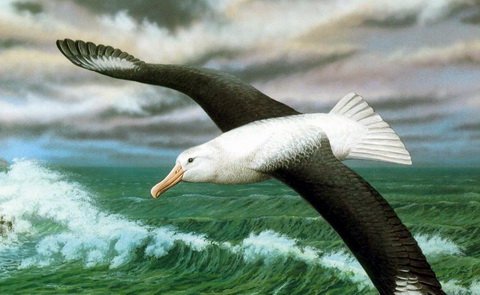Wandering Albatross
From Wikipedia, the free encyclopedia
The Wandering Albatross (Diomedea exulans), is a large seabird from the family Diomedeidae which has a circumpolar range in the Southern Ocean. It was the first species of albatross to be described, and was long considered the same species as the Tristan Albatross and the Antipodean Albatross (in fact a few authors still consider them all subspecies of the same species). Together with the Amsterdam Albatross it forms the Wandering Albatross species complex. The Wandering is the largest member of the genus Diomedea (the great albatrosses), and is one of the best known and studied species of bird in the world.
The Wandering Albatross has the largest wingspan of any living bird, with the average wingspan being 3.1 meters (10.2 feet). The longest-winged examples verified have been about 3.7 m (12 feet), but probably erroneous reports of as much as 5.3 m (17.5 feet) are known. The length of the body is about 1.35 m (4.4 feet) with females being slightly smaller than males, and they weigh typically from 6 to 12 kg (13-26 lb). Immature birds have been recorded weighing as much as 16.1 kg (35 lb) during their first flights. The plumage varies with age, but adults have white bodies with black and white wings. Males have whiter wings than females with just the tips and trailing edges of the wings black. They also show a faint peach spot on the side of the head. The Wandering Albatross is the whitest of the Wandering Albatross species complex, the other species having a great deal more brown and black on the wings and body as breeding adults, very closely resembling immature Wandering Albatrosses. The large bill is pink, as are the feet.
They feed on squid, small fish and on animal refuse that floats on the sea, eating to such excess at times that they are unable to fly and rest helplessly on the water.
They lay one egg: it is white, with a few spots, and is about 10 centimetres (4 inches) long. At breeding time they occupy loose colonies on isolated island groups in the Southern Ocean, such as Crozet Islands, South Georgia, Campbell Island, New Zealand, Auckland Islands, Marion Island, Prince Edward Island, Kerguelen and Macquarie Island. Their nests are large cones built of vegetation that are 1 metre wide at the base and half a metre wide at the apex.
Sailors used to capture the birds for their long wing bones, which they manufactured into tobacco-pipe stems. The early explorers of the great Southern Sea cheered themselves with the companionship of the albatross in their dreary solitudes; and the evil fate of him who shot with his cross-bow the "bird of good omen" is familiar to readers of Coleridge's The Rime of the Ancient Mariner. The metaphor of "an albatross around his neck" also comes from the poem and indicates an unwanted burden causing anxiety or hindrance. In the days of sail it often accompanied a ship for days, not merely following it, but wheeling in wide circles around it without ever being observed to land on the water. It continued its flight, apparently untired, in tempestuous as well as moderate weather.
http://en.wikipedia.org/wiki/Wandering_Albatross
| The text in this page is based on the copyrighted Wikipedia article shown in above URL. It is used under the GNU Free Documentation License. You may redistribute it, verbatim or modified, providing that you comply with the terms of the GFDL. |
|

